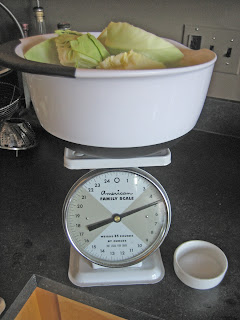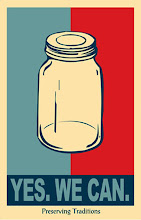This video has nothing to do with canning or adorable conures sleeping in my hand, but it does combine my all-time favorite movie and my barely-contained fury over the last decade. Thanks, Reagan, and all you doofus Chicago School economists, for ushering in the era of laissez faire on crack.
Wednesday, December 30, 2009
Best You Tube video I've seen all year
Monday, November 23, 2009
Cecilia's All Hopped Up (for a minute)
Whenever the sun is out this time of year (rare for Detroit) Cecilia gets a little wacky in the morning- she jumps on all the furniture, chews on anything new, such as this Esquire. But it's over in a flash and soon enough she returns to her regularly scheduled all-day nap.
Sunday, November 22, 2009
ServSafe study day
---
ServSafe is a national certification for food handlers. I have to pass the test before I can even register for pre-requisite culinary classes- my test day is December 8. I began studying for the test today- chapter 2 on pathogens is a toughie- but a lot of the stuff is common sense and/or interesting enough to remember.
I'm going chapter by chapter, making outlines, taking end-of-chapter tests, and doing pretty well so far. But the deeper I get, one thing keeps occurring to me: In the little local, seasonal cafe of my dreams, everything I want to do is illegal.
Real food, by federal SafeServ standards, is considered pathogenic. Here's the list of road-bumps so far.
-Real milk and cheese? Check. Real milk illegal in Michigan, but real cheese can be served after 60-days' aging. Unclear if I can make it in-house, though.
-Local, backyard/ community garden suppliers? May have to jump through crazy hoops for certification- especially with the new hyper-restrictive, over-legislated Food Bills (I'm looking at you, SB510) coming through. Check.-Garden or greenhouse out back? Probably- if it's not an "approved supplier"- Check. (I smell zoning troubles, too.)
-Worms to recycle kitchen waste? Likely considered vermin. Check.
-Making or handling "unusual" foods- you know, freaky stuff like lacto-fermented foods or on-site smoked meats- will require Hazard Analysis and Critical Control Point (HACCP) procedures and will be a Giant Pain in the Butt.
So, blah.
Thursday, November 19, 2009
The 10th Annual Weston A Price Foundation Conference-- my .02
When I sum up the WAPF in a single short sentence (to someone who's eyes are already glazing over), I usually say they promote pre-industrial foods and food systems.
For those who want more info about what the Foundation does, here a link to the WAPF home page.
Last weekend's conference was my first. It was truly fabulous to walk into a room full of real-food foodies-- attendance was about 1100. It was great to not get the blank stare (or alternatively, the look of terror) when waxing rhapsodic about fermentation and raw milk. And the meals were divine.
So- best parts of the conference were the food and my fellow attendees.
I doubt I'll attend again- but I'm glad I went at least once. It is really nice to know I'm not alone.
Wednesday, November 11, 2009
The Magical Stuff that Makes Blue Cheese Blue
(Best fungus ever)
This is the stuff, baby- Penicillium roqueforti. It came in the mail yesterday from Leener's and I'm thrilled to my toes.
When I get back from this weekend's 10th annual Weston A. Price convention (this year in Chicago!), I'm taking the plunge and making Roquefort. My mouth is watering just thinking about it.
Rajiv Shaw Named Head of USAID
Rajiv Shaw
USAID stands for the US Agency for International Development. That's the agency that oversees economic development, agricultural assistance, and famine relief in developing nations. The USAID states the three pillars of their mission are economic growth, agriculture, and trade. They are under the umbrella of the State Department, so Hillary Clinton is the big boss.
Shaw, who is only 36, had most recently been undersecretary and Chief Scientist at the Department of Agriculture under Tom Vilsack; he worked on food safety, climate, and energy. Before that he was an executive at the Bill and Melinda Gates Foundation. He was also the health care policy advisor to Al Gore during his presidential bid. His education is in medicine and health economics. By all accounts, he's brilliant.
However, the recent Big Ag-friendly, band-aid policies coming out of the US Dept of Agriculture certainly give me pause. And it can't go without mentioning: The Gates Foundation has close ties to Monsanto.
Certainly, filling this post is a good thing. It's been empty since the beginning of Obama's tenure, and the agency has apparently suffered for it. The Obama administration has stated that they are keen to make development a central tenet of foreign policy. The agency was formed in 1961, and word is, it's still run like a 1960's bureaucracy.
But I'm still concerned. US relief policies have far more to do with WTO-style economics than with actual, well, relief. It will be interesting to see if Shaw continues to carry the water of the WTO. I wonder if he has any choice in the matter, or if he even sees it as a choice to make.
Sunday, November 8, 2009
Sauerkraut, Illustrated
I make sauerkraut about once a month, in cabbage season (about July through December). Traditionally, kraut is only made in the cooler months- but since I ferment at room temperature, I'm not constrained by weather.
I put up 15 pounds for fermenting yesterday; here's the blow-by-blow:
First, I quarter and core the cabbages. I like to quarter first because it makes coring easier.
Next, I weigh the quarters. Typical kraut-to-salt ratio is 5 pounds of cabbage to 3 tablespoons salt. Be sure to use canning salt, not table salt. 

Shredding is next. Yes, it takes a long time, but this shredder works great.
It's a Japanese "Super-Benriner" shredder- fabulous artwork on the box.
Here's the first 5 pounds shredded in the crock. It goes nearly to the top. I shred 5 pounds at a time, add the 3 tablespoons of salt, then stomp away.
Here's my kraut stomper. It's about the size of a baseball bat, but flat on the business end. I found this stomper in an antique store last year, but you can get them new from Lehman's.
Stomping is absolutely the most important step of making kraut. If you don't stomp it, you'll just have salty shredded cabbage. I stomp for at least 20 minutes per 5-pound batch. I stomp until it sounds really squishy and looks translucent.
Here it is after it's been stomped. See how much the volume is reduced?
After all the cabbage is processed, "plate it and weight it" just as you would any lacto-ferment. While cabbage (especially freshly picked cabbage) does release a lot of it's own juice, it's rarely enough for the one or two inches of liquid you need above the plate. I usually add about two quarts of filtered water with 3 tablespoons of canning salt per quart- same ratio of salt you'd use in any fermenting vat. FYI, this vat is a 4-gallon vat. Some people don't spice their kraut, but I use garlic and juniper berries.
Be sure to cover the vat to keep out the critters and dust. I use a piece of clean muslin (it needs to breathe) and a rubber band to secure it. Store the vat in dim light or in the dark.
(After a couple of days mold will form on top of the liquid- and the mold re-forms every day or so thereafter. You must skim off the mold and add more brine as necessary. At room temperature, the vat is typically ready to eat in about two weeks. It will take longer if the room is cooler.)
I don't add any vinegar. Once you add vinegar (and heat if you're canning), the beneficial bacteria die. Instead, I store it in quart-sized canning jars in the fridge. If I had a root cellar, I'd store it there. But we eat it quickly, so storing is not a huge issue.
Be sure to cover the vat to keep out the critters and dust. I use a piece of clean muslin (it needs to breathe) and a rubber band to secure it. Store the vat in dim light or in the dark.
(After a couple of days mold will form on top of the liquid- and the mold re-forms every day or so thereafter. You must skim off the mold and add more brine as necessary. At room temperature, the vat is typically ready to eat in about two weeks. It will take longer if the room is cooler.)
I don't add any vinegar. Once you add vinegar (and heat if you're canning), the beneficial bacteria die. Instead, I store it in quart-sized canning jars in the fridge. If I had a root cellar, I'd store it there. But we eat it quickly, so storing is not a huge issue.
Now, there's always some cabbage left over- the finger guard that's supposed to let you get down to the nub of the vegetables doesn't really work for me. So I make cabbage soup. Typical Russian recipe, but instead of dill and marjoram, I use fresh sage and smoked paprika. Those two are such a great combo with cabbage and potatoes.
That's all there is to sauerkraut. It's a time investment- usually takes all afternoon- but it's so totally worth it.
Subscribe to:
Posts (Atom)
















